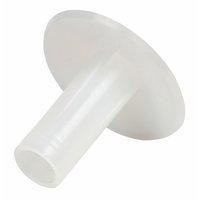As part of a bathroom refurbishment project, I'm planning to install a heated towel rail and electrical element, so it will be dual fuel.
For the warmer Summer months, the rail will be controlled by a 7 day timer and one that I'm looking at is the Sangamo Powersaver Select.
I'm currently purchasing everything I need and will install as much as I can before the electrician arrives at the end of the month to connect up.
The element will be 600W and there will be an outlet face plate installed near to the towel rail, which will be installed opposite the shower entry, in Zone 2. Actually, the rail will be 95cm from the shower entry, which I guess means it won't be in any Zone, but it feels like it should be treated as Zone 2 as it is a walk in shower.
The outlet will simply be a tidy way of routing the element cable out through the bathroom (tiled) wall, although it may also need to be a connection point if the element cable isn't long enough to reach where it needs to go.
The timer will be fitted on the other side of the bathroom wall in the hallway.
I had assumed that an FCU would also need to be purchased to fit between the timer and the ring main/consumer unit, depending on how the electrician wires it up, however, according to the installation instructions for the Sangamo timer it states:
"Provision must be made in the fixed wiring for a means of disconnection from the supply having a contact separation of at least 3mm on all poles. This can be provided by the consumer unit."
Is this last sentence suggesting an FCU is NOT required? Our consumer unit has a number of RCD and MCB's protecting the various circuits.
Also, can anyone recommend a white fuse outlet that has the relevant IP rating? Most of the outlets I can see simply have holes in them for the flex and don't appear to have any grommets or anything that would make them water tight.
For the warmer Summer months, the rail will be controlled by a 7 day timer and one that I'm looking at is the Sangamo Powersaver Select.
I'm currently purchasing everything I need and will install as much as I can before the electrician arrives at the end of the month to connect up.
The element will be 600W and there will be an outlet face plate installed near to the towel rail, which will be installed opposite the shower entry, in Zone 2. Actually, the rail will be 95cm from the shower entry, which I guess means it won't be in any Zone, but it feels like it should be treated as Zone 2 as it is a walk in shower.
The outlet will simply be a tidy way of routing the element cable out through the bathroom (tiled) wall, although it may also need to be a connection point if the element cable isn't long enough to reach where it needs to go.
The timer will be fitted on the other side of the bathroom wall in the hallway.
I had assumed that an FCU would also need to be purchased to fit between the timer and the ring main/consumer unit, depending on how the electrician wires it up, however, according to the installation instructions for the Sangamo timer it states:
"Provision must be made in the fixed wiring for a means of disconnection from the supply having a contact separation of at least 3mm on all poles. This can be provided by the consumer unit."
Is this last sentence suggesting an FCU is NOT required? Our consumer unit has a number of RCD and MCB's protecting the various circuits.
Also, can anyone recommend a white fuse outlet that has the relevant IP rating? Most of the outlets I can see simply have holes in them for the flex and don't appear to have any grommets or anything that would make them water tight.


